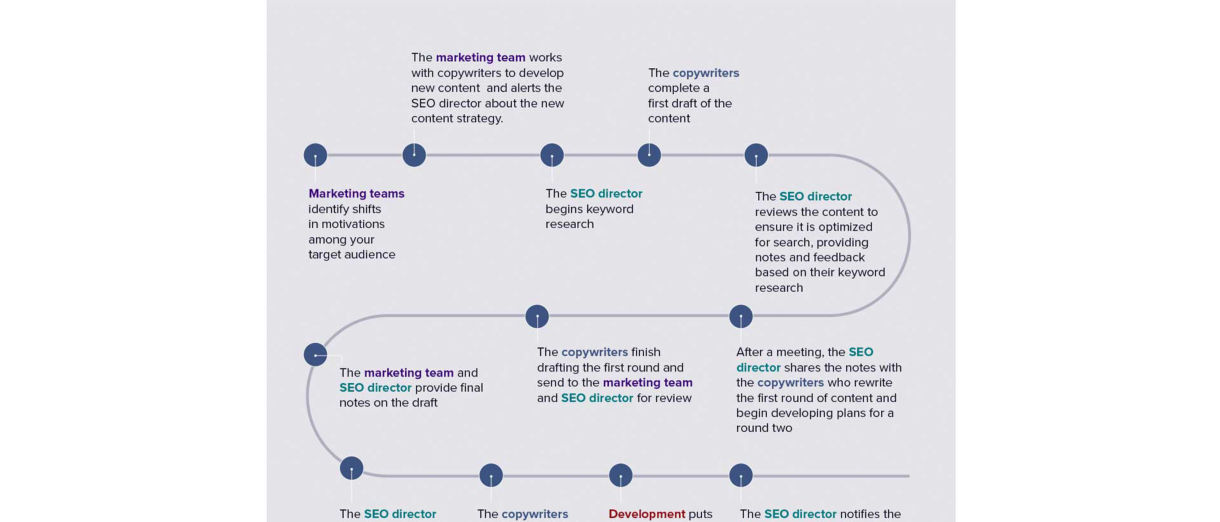Enterprise SEO is a process that helps large-scale organizations keep their websites optimized to compete for visibility in search results. It requires dedicated SEO subject matter experts collaborating with UX, development, marketing, and content teams to apply content and technical optimizations at scale. That is a lofty objective, as enterprise organizations struggle to keep pace with the ever-evolving landscape of search results. In the first three months of 2023, Google has reportedly already made 12 updates to how it crawls, indexes, and returns search results, but only two of those updates were actually confirmed by Google.
Why Developing an Enterprise SEO Program is Necessary
Search moves quickly, and large-scale organizations can struggle to keep pace if they don’t have a program that adequately incorporates SEO into existing workflows that impact their website. Your organization can risk forfeiting visibility to competitors as you struggle to publish optimized content. Google, Yahoo, Bing, and other search engines are moving fast to improve the search experience. Organizational roadblocks can greatly hinder your site's ability to adapt to changes in search algorithms.
As fast as search engines are, the market can shift even more quickly. Search behavior can turn on a dime as new interests and trends go viral. As an example, search interest in “home gyms” skyrocketed during March of 2020 as consumers sought to maintain their workout regimen without access to a gym.
Sites that had the ability to quickly develop and publish content that could target this phrase and other relevant keywords had an edge over slower competition. Being able to respond quickly to shifts in how your target audience is searching requires multiple independent teams to coordinate efficiently through a number of tasks to get optimized content on the website. An example workflow could look like this:

If this process seems convoluted, it is because I wrote it that way. But this mirrors real-life scenarios of trying to get optimized content on a site in a timely manner. There were missed opportunities across the workflows that could have decreased the production time and allowed this organization to push out competitive content much faster.
A Case Study in Enterprise SEO
If done correctly, enterprise SEO pays off. Consider one large retailer we worked with to optimize their landing pages for Black Friday & Cyber Monday promotions. We helped them create an entirely new workflow to address needs for QA, internal linking, merchandising, keyword research, copywriting, and more. We also made the case for early optimization to tentpole landing pages to reach consumers searching early for these promotions. This work resulted in:
- Y/Y growth in organic revenue (61%), ecommerce conversion rate (32%), and new organic users (4%) for the Black Friday page
- Y/Y growth in ecommerce conversion rate (13%) and new organic sessions (17%) for the Cyber Monday page
- Y/Y growth in sitewide organic revenue (54%) and sitewide ecommerce conversion rate (33%), and a decrease in sitewide organic bounce rate (20%)
To achieve results like these requires coordination among the marketing teams who help set the sales calendar, the development team who prepares the pages, the copywriters who update the content, and the SEO team who ensures the pages are ready for search. This entire process requires careful coordination months ahead of time. A clear workflow with documented procedures helps ease coordination and yields the type of gains seen in this case study.
Elements of Enterprise SEO
To increase the speed of getting optimized, targeted content live on your site, there are key elements that most successful SEO programs have in common:
Access to Leadership
Even if your organization has an SEO director, that role typically doesn’t have as much reach as an EVP in marketing. Having executive sponsorship is necessary to help evangelize how SEO provides value and what support is needed to have a successful SEO program. A point person from the C-suite can educate the leadership team on the importance of search engine optimization and how it aligns with the organization's goals and objectives. With access to leadership, enterprise SEO teams can make the business case for implementing SEO initiatives that drive results.
Shared Project Management
In an ideal enterprise environment, teams share a single management system that allows for insight into most initiatives that impact the website. Shared project management facilitates collaboration and ensures that each team understands its role in the SEO process. Tools such as JIRA and Trello can help coordinate projects and ensure each team is represented for relevant tasks.
Cross-Functional Teams
Marketing, development, content, and SEO teams have to work together and collaborate frequently to ensure that the website is optimized for search engines. This approach also ensures that all changes made on the website are consistent with the business goals and allows for initiatives to be planned together. Some organizations utilize standing cross-functional teams that have specified objectives. For example, a global organization can establish a web marketing team in different regions with reps from paid search, social, nurture, SEO, development, and analytics all working together to carry objectives for their dedicated region.
Pilot Programs Prove Value
Pilot programs are small-scale executions that help showcase the value of recommended tactics. SEO teams at enterprise organizations can use pilot programs to test strategies before implementing them across the website. These programs help to demonstrate the potential impact of new SEO initiatives and help justify the investment required to implement them before applying the ideas on a wider scale.
Documented Procedures
In an enterprise SEO environment, it's essential to document procedures. There is an expectation that these procedures will be deferred to when applicable. Documentation ensures that all teams understand how to execute SEO strategies correctly and provides a reference point for new team members who may join the enterprise SEO team later. These documented procedures can include:
- RACI maps to identify core responsibilities for any number of tasks like publishing a blog post or removing a web page.
- SOPs to identify specific processes for SEO. As more are created, there is an opportunity to build a whole library dedicated to Schema, Sitemaps, Robots.txt, etc.
- Templates to ensure other teams are following recommended SEO tasks. Templates work especially well with for content development because SEO teams can identify specific areas on new pages that require optimization and call out requirements such as length of the page title, code requirements for the header, number of subheadings, etc.
So How Can You Get Started?
Internal Audit
An audit of your internal processes can be a great way to identify where your organization needs to improve to include SEO. Start by tracking the process of how updates are made to the front end of the website and which teams are responsible for those updates. Meet with the marketing, development, content, and UX teams to ask about their understanding of SEO and where they believe SEO should fit into their workflows. This will help you gauge your weak points and begin developing a program from there.
Conduct Trainings
A great way to spread the value of SEO in an organization is through training sessions. Programs like lunch and learn sessions can be fun ways to build relationships between teams who haven’t worked together as closely as they should.
Get Support Among Leadership
Aligning SEO processes with organizational objectives is helpful in getting executive sponsorship to drive these initiatives. Start by building a business case to show the value of SEO and how it directly impacts the organization as a whole.
Establish and Document Workflows
Audits, trainings, and meetings to discuss business cases will help increase the internal network of stakeholders interested in SEO. To put that network to work, you’ll need agreed-upon processes and workflows to ensure SEO is being included in processes that impact the website. Make sure to document those procedures so they can be easily shared and referenced by key stakeholders and new team members.
Don’t Stop
Once you’ve gotten buy-in from the organization, you need to keep the pressure on. Establish relationships with new teams. Keep offering trainings. Make it fun. Throw pizza parties. Host office hours or virtual coffee breaks. Just as continual maintenance of a website is necessary to stay relevant in search, so is continual maintenance of your enterprise SEO program.
Conclusion
Bringing together multiple teams to form an enterprise SEO program can feel like an overwhelming initiative. However, with the right processes in place and frequent coordination, your brand can realize the benefits of enterprise SEO and provide better experiences for your customers.






